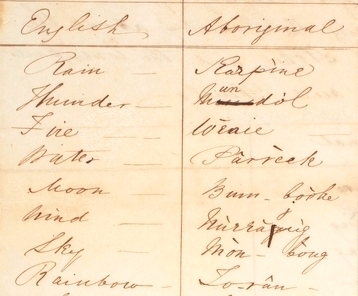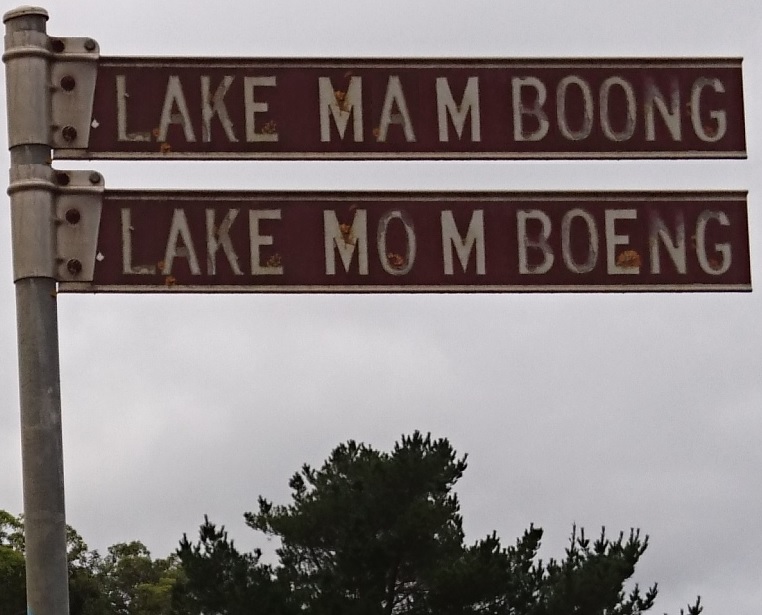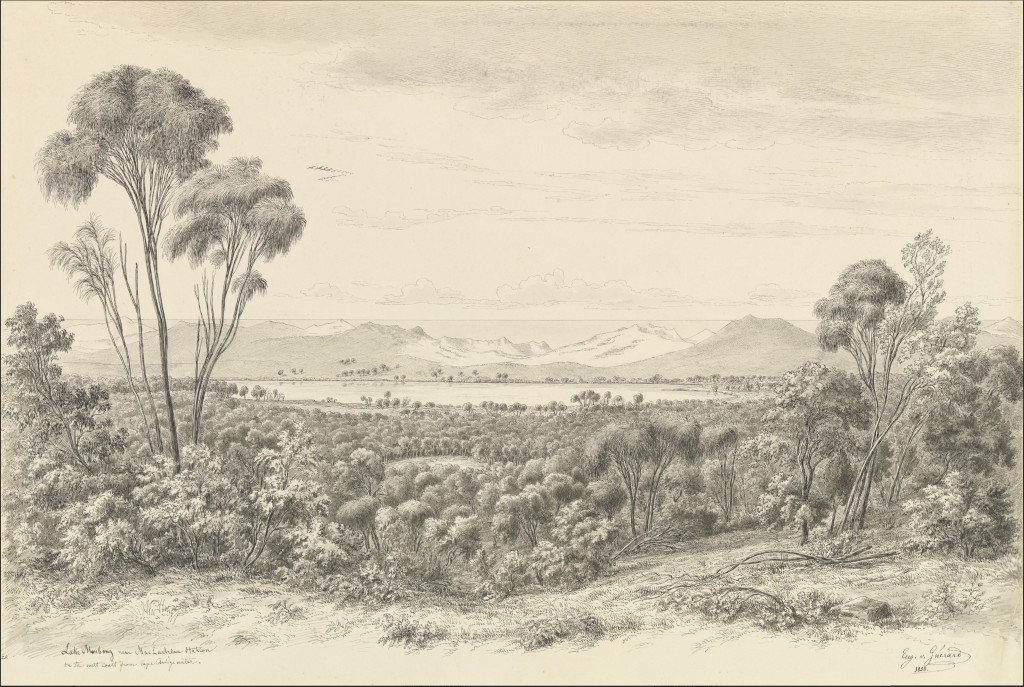Part 7: The Lake Momboeng Naming Story – Does a tantalising clue reveal a deeper mystery about our local Indigenous languages?
In the previous blog of this series (Part 6), we finally uncovered how the Lang Brothers wanted their run named in 1848.
As we explored in Part 4, Gideon Lang paid more attention to the language and activities of the Indigenous people he encountered than many of his contemporaries, and on that basis alone, I had placed increasing importance on trying to uncover the name of the run, if possible, as he wrote it. We now know that in April 1848 he wrote the name as Lake Momboeng, following the lead of his older brother Thomas who filled in the application forms in January 1848 with the same spelling.
However, using European English in a written form to describe any Aboriginal language, as it was spoken and heard, was (and remains) a significant challenge.
Hence there is a strong possibility that two people who may have heard the same word, would choose to try to spell it differently. And so I have wondered, does this mean that the Lang Brothers themselves may have refined, adapted or evolved the way they spelled the words they were hearing spoken by local Indigenous people, over time to try to better match their phonetics? Or did they perhaps disagree about how the word should be spelled, which is also highly likely?
With this in mind, a tantalising clue has been revealed in the archives to suggest the answer could be yes – and is consistent with some research provided to me a few years ago by Joel Wright, an expert who works on the Laka Gunditj Language Program, for the Victorian Aboriginal Corporation for Languages.
That single clue is found on a Stock Return of Persons to be Licensed – dated 1st July 1847 – revealing the earliest yet recorded name of Lake Mamboong. After being transcribed into this register, does this spelling represent a different earlier opinion from one of the three Lang Brothers, as submitted on their paperwork? Or could it represent the spelling as heard and written down by the Portland Bay Commissioner of Crown Lands, Foster Fyans, after visiting the Lang Brothers at their run?

Stock return of persons to be licensed – dated 1st July 1847 – revealing the earliest recorded name for the Lang Brothers’ run of Lake Mamboong (accessed at the Public Records Office of Victoria)
Unfortunately, no other paperwork has been located to show if the Langs ever used this spelling before 1848, but there are other key pieces of potentially inter-related evidence that make this particular spelling (including the phonetic interpretation it implies) harder to simply dismiss.
Firstly, the surveyor Charles Tyers (later appointed the Commissioner of Crown Lands for Gippsland) recorded a number of local Aboriginal words in 1842, after his travels as a surveyor around far SW Victoria.

Extract of page 2, from Charles Tyers’ handwritten notes from 1842 of the “Vocabulary of the language spoken by the Tribes inhabiting the Country about the Rivers Crawford, Stokes, and the lower parts of the Wannon and Glenelg.”
On page 2 of his notes he records the word for “Sky”, as being Mòn-bòng. I don’t have any training in linguistics and unfortunately he didn’t provide a key to his notes, but if the accent over the vowels indicates the speaker should use a longer vowel sound (i.e. not simply saying a short “o” sound, as in the word “pot”), then it raises some interesting possibilities. The fact that there are so many different ways of saying “o” with a longer vowel sound in English, including the way the long vowel sound interacts with the letters after it, actually makes this quite a challenge for a linguistics novice like me.
However, another early interesting reference I have come across is part of a much larger and more detailed vocabulary, recorded in 1862 by William Thomas (1793-1867), a long serving assistant protector and guardian of Aborigines in Victoria during the phase immediately following first contact. Thomas’ unpublished manuscript, entitled “Lexicon of the Australian Aboriginal Tongue in the Six Dialects of Ballaarat, Bacchus Marsh, Melbourne, Gipps Land, Mount Gambier & Wonnin”, shows the significant attempt he made to comparatively document the key Indigenous language groups of southern Victoria.
In another fascinating clue, in the “Wonnin” language (the dialect he documented to the east of the Mt Gambier (Bunganditj) language region, numbered 6 in his notes), Thomas recorded the word for “the clouds” as “Murn-boong”.
Extract of page 111, from William Thomas’ handwritten notes from 1862 of the “Lexicon of the Australian Aboriginal Tongue in the Six Dialects of Ballaarat, Bacchus Marsh, Melbourne, Gipps Land, Mount Gambier & Wonnin.”
We are also fortunate that unlike Tyers, Thomas left a detailed phonetic key, to ensure future readers could at least try to make sense of the various accent symbols he placed above vowels, and assist the speaker with pronunciation.
Extract of Phonetic Schedule, from William Thomas’ handwritten notes from 1862 of the “Lexicon of the Australian Aboriginal Tongue in the Six Dialects of Ballaarat, Bacchus Marsh, Melbourne, Gipps Land, Mount Gambier & Wonnin.”
This tells us that each “o” is said as in rope, each “u” as in cut, and “ng” (at the end of words) as in ring.
By playing with the possibilities for this word (why not try it yourself?), and given the similarity between an “m” and “n” sound, you can see words could very quickly be transcribed (or, especially depending on the speed of speech, potentially heard by a European listener) in slightly different ways. In this context, both written forms of very similar words like “Momboeng” and “Mamboong” appear to have considerable phonetic overlap, especially for the second part of these words. And so, all of a sudden (and thanks to the definite removal of the “i” in the erroneous name “Moniboeng”, as explained in Part 6), from a phonetic perspective all these words begin to look distinctly like they are closely linked.
But that is not all.
In our correspondence, Joel Wright also highlighted research (by Dr Barry Blake) indicating that the languages spoken by Dhauwurd Wurrung / Gunditjmara people (of SW Victoria and Discovery Bay) and Bunganditj people (in adjacent areas to the west and north) have an overlap of around 40%.
Of particular relevance, he also identified a reference in Christina Smith’s 1880 book about the Bunganditj (i.e. Booandik, as spelled by Christina) people, where the term “Mam-bo-ong” was recorded, with the dashes giving some clues about the number of syllables and/or how it was pronounced. That passage is shown below:

The passage from Page 79 in Christina Smith’s book from 1880, that refers to the Mamboong, or Great Spirit.
After what we’ve now discussed here, could this just be a co-incidence? In short, I no longer think so.
This reference to a “Great Spirit” also specifically includes the two brothers looking up to the sky at night; immediately giving considerable overlap to the meanings of the words we have explored (sky, clouds and spirits above). Considering that European listeners may not have fully understood the contexts in which the word was or could be used, and the fact that many early accounts describe in detail Indigenous stories of spirits and/or afterlife that involve the clouds and sky, this overlap becomes even more likely. As we know, double and triple meanings happen all the time in English!
Additionally, to illustrate just how two people in the same place, hearing the same Aboriginal word, might record them differently, it has also been fascinating to recently be shown a photocopy of an unpublished Bunganditj-English word list written by Duncan Stewart (Christina Smith’s son) in the 1870s (Geoff Aslin collection, Mt Gambier). Duncan was still a boy (of 11 or 12 years old) when he arrived in the lower South East in 1845 with his mother and step-father (James Smith).
As a result, he spent his formative teenage years among the children of the Bungandtij clan at Rivoli Bay south (present Southend). From the age of 14 he was engaged as a translator (and later employed as a government interpreter in 1853), being one of the only fluent non-Indigenous speakers of the Bunganditj language, and having significant first-hand involvement in the affairs of Indigenous people over the tumultuous years that followed first contact.
As you can see below, Duncan, who (having arrived in Melbourne from Scotland at 6 years of age with his mother in 1839) perhaps wouldn’t have had quite the same type or extent of ingrained Scottish accent bias as his mother, differed in his opinion of how the word for spirit – “Bo-ung” – should be spelled. His definition of Bo-ung was: “one’s life or soul. Some held that they held two Boungs. At death one went down west into the sea and would return as a white man. The other boung went up into the cloud lands where things existed much the same as here but food better and plentiful.”

Extract from a photocopy of Duncan Stewart’s Vocabulary Diary from the 1870s
(from Geoff Aslin Collection, Mt Gambier).
Again we see here the overlap in meaning for this key second component in the name of Lake Momboeng. Indeed, everything is now pointing to the fact that this part of the name very clearly describes the term bo-ong (or alternatively bo-eng / bo-ung) for spirit.
However, to come to a conclusion about the first part of the name requires a little bit more thought. To help us with this task, let’s look back at Thomas’ word list earlier in this article… and you’ll see that to “clap the hands” is actually recorded as “Murn”, the first part of the apparent compound word listed for “the clouds”. Hence, it would seem entirely possible that when Thomas pointed to the clouds and asked his Indigenous informant what they were called in their language, that he may have been told “Murn-boong” or literally, “thunder-clap spirit”.
Noting that Christina Smith in her book records the Bunganditj word “murn-dal” for “thunder”, and “marm” (recorded elsewhere as “mam”) is listed separately for “father” – it seems plausible that Murnboong and Mamboong are two different (but related) compound words to describe two of the spirits in the sky.
However, the phonetic similarly between “Mam” and “Mom”, depending on how the vowel is pronounced, and the fact that the name Mamboong (1847) and Momboeng (1848) were the first two names recorded (both during the Lang Brothers’ tenure) for the lake, strongly suggests that these names mean and describe exactly the same thing and are directly linked to the meaning ascribed in Christina Smith’s book.
So finally, let’s head back to the coast and think about the site itself. Anyone who has been to Lake Momboeng knows it is a special place – and with permanent fresh water, situated near the coast, it must have been incredibly significant to local Indigenous people. Was it a sacred place, significant enough to be named after the “Great Spirit” or “Father Spirit” as local Indigenous people understood it, or was it named as such simply because of its crystal clear spring fed waters reflecting the sky, the stars, or the cloud lands where the ancestors’ spirits reside?
While we may never know the answer to this question, or indeed the precise way the word was spoken, we are now a lot closer to a version of the truth that makes a lot more sense than when this story began. But where does this leave us now?
Well, for many years now Parks Victoria have followed local historian Noel Learmonth’s suggested name of Monibeong, as explored in Part 3, while the Glenelg Shire have retained the current official place name Mombeong, after the Place Name Committee came very close to the adopting a more accurate spelling (Momboeng) in the 1970s. As we learned in Part 5, they were influenced in the end by submissions that asked them to choose a spelling that ‘sounded better’ and was ‘easier to pronounce’.
So after everything we’ve explored, what do you think?
Should the word be written as Momboeng, Mamboong or, based on Duncan Stewart’s notes, Mamboung? Or perhaps the current accepted written form of this word, based on the modern phonetic interpretation suggested by Barry Blake (as listed in the glossary of Blake 2003) – Mambuwang?

Maybe two signs would cover it!? A potential solution for future signage on the
Portland-Nelson Road
(Note: original image digitally modified)
For the time being, on the basis of this research, we’ll go with the Lang Brothers’ 1848 spelling of Momboeng in NGT reports and articles.
But as Joel reminded me in our correspondence, ultimately the decision about what the Lake should be formally recognised as in the future, should rest with the traditional owners of the country – in this case the descendants of the Gunditjmara and/or Bunganditj people who lived in and cared for this incredibly important coastal ecosystem for millennia.
I hope this research is a valuable tool for any future deliberations that might occur in that regard.
PS – Eugene von Guérard also thought Lake Momboeng was special enough to sketch it on his journey through the area in 1858. Enjoy the view… and note the bare, drifting dunes!


